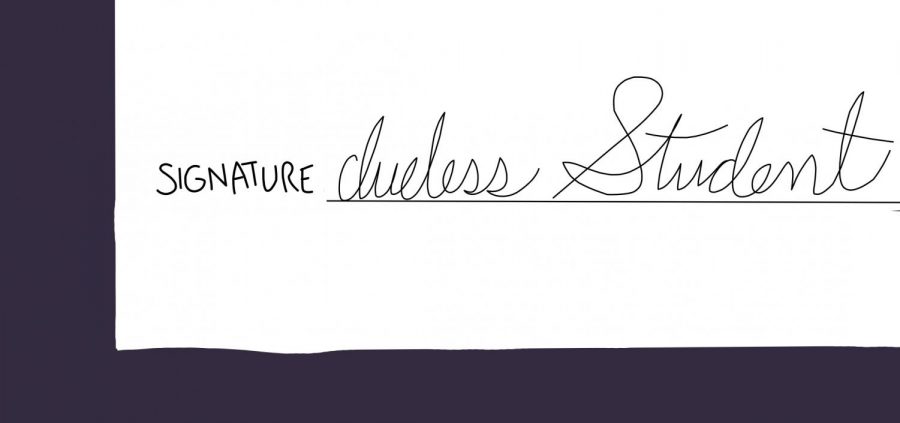Opinion | 10 things to do before signing a lease
October 13, 2020
After spending a year in on-campus dorms, the prospect of living off campus is exhilarating. Living in Oakland with no security guard or RA sounds like the ultimate freedom. But this independence can be quickly soiled by a slumlord and a crappy house.
Landlords are often just looking for a check, and they are often not looking out for students’ best interests. They sometimes take advantage of students’ naiveness and hastiness to sign a lease and purposefully neglect to mention alarming issues. Most students don’t have the advantage of having their parents accompany them on house or apartment tours, so there’s a few things you should do before signing a lease.
- Read the entire lease
Landlords say a lot of puffery and promises to convince students they will be taken care of. But the only guarantees landlords must honor are physically written on the lease. Landlords sometimes hide sketchy rules and regulations in the lease within lines of normal information, so students might overlook it. Read the entire lease and if something doesn’t seem right, ask the landlord to clarify or even rewrite a statement to ensure they’re not using odd phrasing to mask a hidden agenda. It’s helpful to ask other people if any odd circumstances or requests on the lease are normal, then to reconsider signing.
- Background check the landlord
Students assume they can trust landlords who rent out multiple properties and appear professional — that’s how this Oakland landlord was saddled with $255,000 in fines. A Google search of their name or typing them into a background check program should be enough to make sure they’re trustworthy. Don’t be shy to ask the landlord for a few references, considering they often ask the tenants for references.
- Make sure the ceiling is intact
It’s easy to miss crucial issues when glancing at the ceiling. A lot of Oakland houses are very old and have sustained significant weather damage, and ceilings take the brunt of that damage. It’s only a matter of time before the tiny bubble on the ceiling turns into a full-fledged hole raining down plaster, paint and debris. Even worse, a damaged ceiling could lead to electrical issues, leaks, mold and structural buckling and caving.
- There should be no draft from the doors
The quality of doors is commonly overlooked but is essential to comfort and wallet. Even a small gap is an issue, as it can run up the heating bill. Gaps also provide an opening for bugs looking for somewhere cozy to live. Though doors are the biggest concern, this applies to windows, too.
- Ensure there are windows
Students might not care about windows during a single tour, but it’s proven that a natural source of sunlight significantly improves function and attitude. Living somewhere with no windows or bad lighting creates a disconnect from the outside world and discourages productivity. Take it from someone who lived in a basement for a year — you want windows.
- Check the condition of floors and carpets
Having sufficient flooring is as important as the ceiling considering a floor is technically another ceiling. Floors face substantial damage, and the last thing a student wants is lifted floorboards, holes or worse — mold. Clean and well-kept carpets are a compelling reflection of how well the landlord cares for the property. Ideally, carpets are replaced after each round of tenants, so ask the landlord the last time they were replaced.
- Pay attention to outlets
Having enough electrical outlets in the home is essential, and the outlets should be three-pronged instead of two-pronged. The difference is that three-pronged outlets are grounded and provide an alternate pathway for electricity in the event of a fault. Without the third prong, the safety feature is eliminated, and an electrical surge could fry every appliance in the house and possibly cause a fatal shock.
- Check for mold
When touring, students assume the house is in safe condition to be seen — sadly, landlords don’t always care about “safe.” Since water damage is common in Oakland homes, mold follows close behind. Mold can be dangerous to breathe in, especially for those with allergies, asthma or lung conditions. Check for mold in places that are warm, damp and dark like under sinks and in the bathroom. Molds take a variety of forms and textures — they can appear white, black, yellow, blue or green and often look like discoloration to a surface or have a velvety, fuzzy or rough appearance.
- Clarify your responsibilities
Typically, not all utilities are included in the lease, but students should not be handling ALL of them. Ask the landlord what utilities they take care of and double-check the lease to make sure — also ask for an estimate on monthly utility costs. Confirm that the landlord would handle other responsibilities, such as changing the furnace filter, fixing or replacing provided appliances and doing necessary repairs. If you have to pay over $5 every time you do laundry, it’s a no.
- Locate heat and air ducts
It’s nice to be provided heat and air conditioning, but if the home doesn’t have central air, consider how useful these accommodations will be to everyone. Make sure every floor has heating and air conditioning that reaches every room so all tenants are consistently comfortable in the home.
Living in a new home is exciting, especially in glamorous Oakland. Don’t ruin your newfound freedom by making a decision based solely off of excitement. There are plenty of homes to choose from, so don’t feel pressured to sign a lease on the first tour. Protect yourself when renting and be smart — to have fun, you want to live somewhere stress-free.
Nina likes to write about things that aren’t talked about enough. Follow Nina on Instagram and Twitter @ninaboebeana or email her at [email protected].








